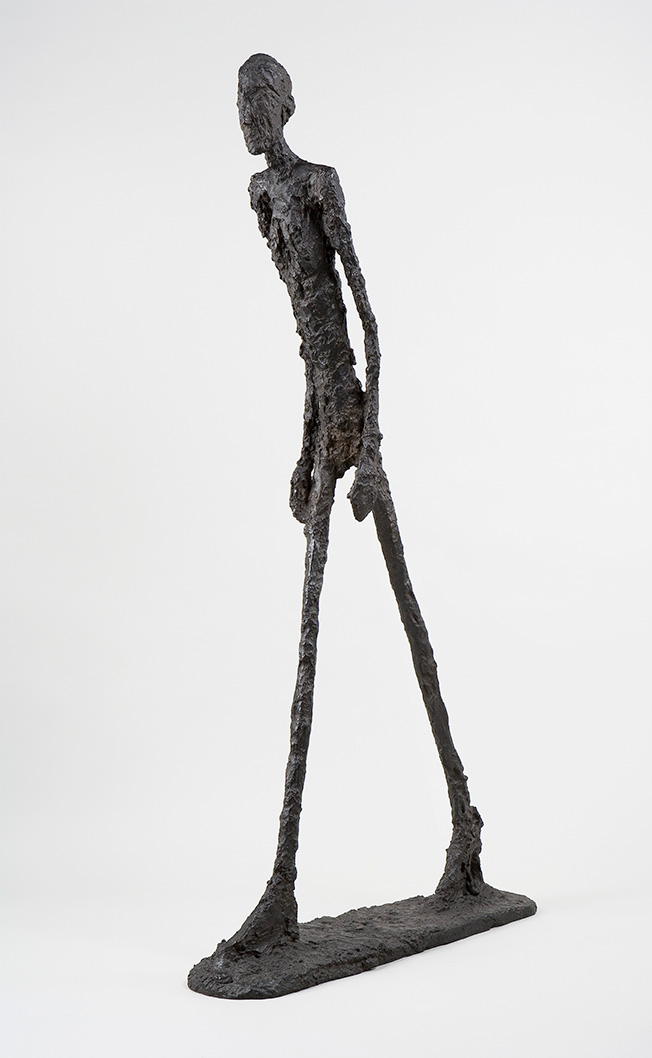
Walking Man I (Homme qui marche I), 1960
“As if the material itself had become an illusion. You have a certain amount of clay, and at first you feel that you've given it more or less the right volume. And then, to make it more real, you take away. You don't do anything but take away. It becomes fatter and fatter. But then, it's like the material itself, you could stretch it to infinity. If you work a little clump of clay, it seems to get bigger. The more you work it, the bigger it gets.” [1]
Throughout his career, Alberto Giacometti (1901–1966) took part in various 20th century avant-garde movements. From the 1950s, he felt drawn by existentialism, whose influence is visible in works like this one, entitled Walking Man I.
Walking Man I is a sculpture from his period of maturity, the culminating point of his artistic career, when Giacometti explored the human figure from different angles. The precariousness of the figure relates to the limits within which every human being has to live in a society subject to multiple conflicts and challenges, and to both natural and man-made disasters. The face is barely defined, the intention being to capture the generality of the human species and so enhance the universal character of what is represented by the piece, arousing a greater sense of identification in every viewer.
The sculpture is made in a single piece of bronze, whose unpolished surface gives an anguished, desolate, and skeletal appearance to the figure and his somewhat loping walk. On this occasion, Giacometti creates a solitary male figure of whom we can make out nothing but the most elementary forms. He has one leg forward as if walking, and he keeps his arms close to his body. The body is also heavily inclined forward, provoking a certain instability that gives the impression the figure is moving through space. Movement, always present in one way or another in Giacometti’s work, is achieved in this case by the arrangement of the thin legs of the figure, whose heels seem to be lifting off the ground as the walk gets under way. Like the legs, the arms are too long and exaggeratedly thin. No signs of muscles are to be seen anywhere on the body. The skin is rough and coarse as though full of scars, transmitting an inherent sensation of intense frailty.
The origins of this sculpture may have a connection with a friend of Giacometti’s, the model Isabel Lambert, whom he often saw during the years she lived in Paris. As he was taking leave of her one night, he saw how she grew smaller as she got further away, although for him her intensity and identity remained the same. Giacometti, who had always tried to represent that subtle instant when the human figure starts to dissolve but has not yet completely vanished, became obsessed from that night on with the idea of turning that vision of Isabel Lambert into a sculpture. [2]
Giacometti devised several sculptures on this theme for a public project commissioned from him by Chase Manhattan Bank for the Chase Manhattan Plaza in New York. However, he finally abandoned the project, for which he made only Walking Man I and Walking Man II. Walking Man I never reached its destination, but was shown at the 1962 Venice Biennale. By way of a curiosity, this work is so iconic that it appears on the back of the 100 franc note in Switzerland, the land of the artist’s birth, and there is also a copy of the statue at the UNESCO headquarters in Paris.
Preguntas
Look closely at this work by Alberto Giacometti. It is made to human scale. Why do you think the artist made it this size? How would the way you see the figure change if it were much bigger or much smaller?
The work captures the movement of someone starting to walk or in the middle of walking. Where has he come from? Where do you think he is going? What would you have to change about the sculpture to give the impression the figure was stationary?
Observe the work closely and discuss why the figure carries no object, accessory, clothing, or amulet. He is also completely on his own, with no other human being, animal or landscape. Why would the artist represent a man walking in complete solitude? What interpretations of solitude occur to you? If you could give him a companion, male or female, who would it be and why?
Like many other works by Giacometti, this one is made in bronze. What would change if it were made in a material other than bronze?
